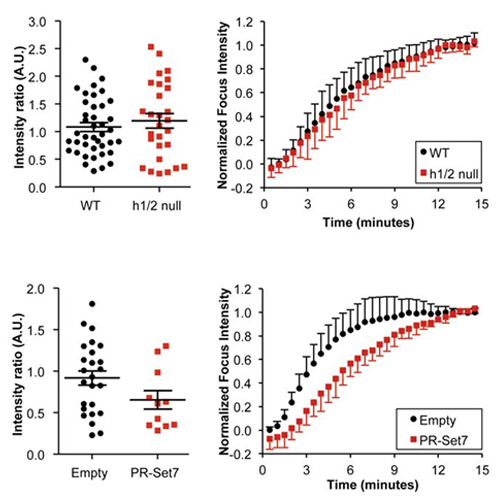Impact of Histone H4 Lysine 20 Methylation on 53BP1 Responses to Chromosomal Double Strand Breaks
28-Nov-2012
Plos one, 2012, doi:10.1371/journal.pone.0049211, 7(11): e49211 published on 28.11.2012
Plos one, online article
Plos one, online article
Recruitment of 53BP1 to chromatin flanking double strand breaks (DSBs) requires γH2AX/MDC1/RNF8-dependent ubiquitination of chromatin and interaction of 53BP1 with histone H4 methylated on lysine 20 (H4K20me). Several histone methyltransferases have been implicated in 53BP1 recruitment, but their quantitative contributions to the 53BP1 response are unclear. We have developed a multi-photon laser (MPL) system to target DSBs to subfemtoliter nuclear volumes and used this to mathematically model DSB response kinetics of MDC1 and of 53BP1. In contrast to MDC1, which revealed first order kinetics, the 53BP1 MPL-DSB response is best fitted by a Gompertz growth function. The 53BP1 MPL response shows the expected dependency on MDC1 and RNF8. We determined the impact of altered H4K20 methylation on 53BP1 MPL response kinetics in mouse embryonic fibroblasts (MEFs) lacking key H4K20 histone methyltransferases. This revealed no major requirement for the known H4K20 dimethylases Suv4-20h1 and Suv4-20h2 in 53BP1 recruitment or DSB repair function, but a key role for the H4K20 monomethylase, PR-SET7. The histone methyltransferase MMSET/WHSC1 has recently been implicated in 53BP1 DSB recruitment. We found that WHSC1 homozygous mutant MEFs reveal an alteration in balance of H4K20 methylation patterns; however, 53BP1 DSB responses in these cells appear normal.











